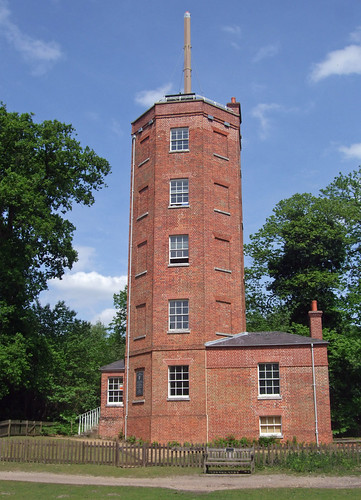
UPDATE: It seems the problem crossing the Wey Navigation reported in December 2016 was resolved in August 2018. See below.
If proof were needed of the variety of countryside around London, today's walk is a fine demonstration. Most of the last section was still within rugged chalk hills -- today there are verdant meadows and rough lowland heaths as well as a celebrated garden, a stretch of towpath and a strip of suburbia. It's entirely outside an area with a major protected countryside designation like the Surrey Hills AONB but in many ways this patchwork of landscape types and land uses makes for a more interesting walk than some of the route's longer treks through the more traditionally "beautiful" wooded ridges.
Heading north from East Horsley, in the Surrey borough of Guildford, along Ockham Road North with its largish 20th century houses, I reach a junction where a strip of woodland beside a lane with the attractive name The Drift has a board announcing it's part of The Forest Community Woodland, a long neglected ancient woodland, once part of Horsley Common, that in 2002 was bought by Surrey Wildlife Trust following an appeal organised by the Horsley Countryside Preservation Society (HCPS). Keith Chesterton's guide to the London Countryway, written many years before, simply has the route following the lane here, but while I can't see an obvious way of rerouting to include more of The Forest, I do at least take advantage of this roadside strip.
This also involves a further brief stretch of the Horsley Jubilee Trail, another HCPS project, its yellow waymarks familiar from the previous section. But otherwise we won't be seeing much signing for named trails today: this section has the lowest proportion yet of paths shared with other "promoted routes" and there won't be another one until we join the River Wey Navigation towpath. Nonetheless all the paths on the route are clear and easy.
Chesterton comments that the Blue Ride, the path leading away from The Forest and up into another, presumably privately owned, woodland, once came under threat when The Drift golf course was created further along the lane, and may have been lost if it wasn't for the persistence of local Ramblers members. As with so many similar paths, there's nothing on the ground to record this fact so most users of what's now a fine, well-maintained path around a field and up into the wood will have no idea they have the Ramblers to thank. The wood is rich in rhodedendrons and climbing uphill I pass through a bower where the shrubs have formed an arch over the route. It's mid-May and the bluebells are still out in force, but I doubt they are the blue that gave the path its name.
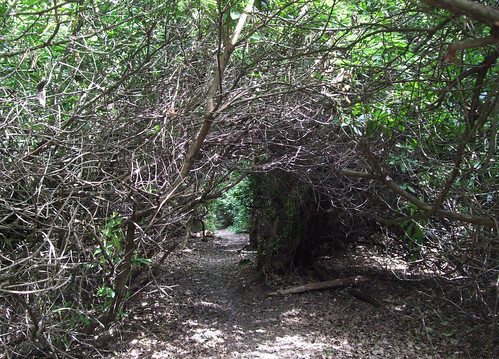
From the Blue Ride the route continues along a fine path between thick hedgerows and lines of mature trees, with gaps on the right giving a view back to the North Downs and earlier sections of the path -- you can see the wooded dip slope and over the top of the ridge a faint line of the further Surrey Hills.
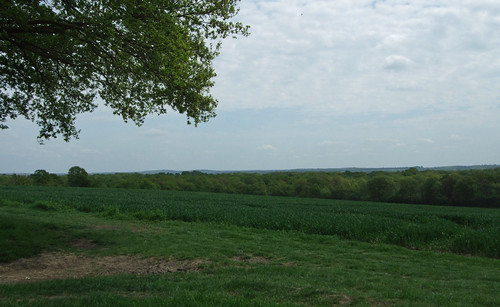
A woodland edge then leads to a road which takes us towards the hamlets of Martyrs Green and Mays Green. There's a walkable verge along the road but a wooden railing, clearly a piece of public path furniture, tempts me up into a field where a broad path runs parallel to the road along the headland on the other side of the hedge. There are no signs indicating this is public but nothing to keep us out either, and it's clearly well trodden. A clatter of phuts emanates from a paintball centre on the other side of the road.
Emerging on a lane near the cottages and farm buildings of Mays Green I almost lose the way: at a complex junction, a well-kept fingerpost distracts me from the correct route, which runs over a low stile just before the fingerpost and across a lawn in what is clearly a private garden.
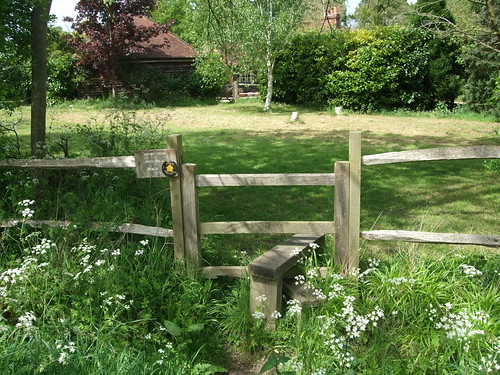
After a narrow stretch between garden fences and a turn around a horse paddock, now in the Surrey borough of Elmbridge, the route continues on a farm track. Here a sign on a gatepost says "Private road -- No unauthorised access" but right next to it is a yellow public footpath arrow pointing confidently ahead.
The system of public rights of way (PRoW) in England and Wales is sometimes described as unique. That's a little misleading, as a number of other countries (including France, Belgium and some US states) have similar categories in their legal systems, but the geographical coverage and density of the network in England and Wales, and its importance to outdoor access, is remarkable. It's very much a product of the principle of "common law" and, as I once heard an erudite German walking campaigner explain to a puzzled Slovenian in a conversation at an international conference, partly a legacy of England's never having had a proper bourgeois revolution to sweep away the remnants of feudal law.
It's sometimes said that under the feudal system, the Lord of the Manor "owned" the land and, in some sense, the serfs that worked it. But for that system to be workable, there were rights and responsibilities on both sides, including the right of the serfs to earn their means of subsistence from what was nominally the Lord's land. As nearly everyone on a particular manor was tied socially and economically to that land and needed access to work it, it would have made little sense to stop people wandering as they chose. Even in pre-industrial but post-feudal times, in any one locality there would only be at most a handful of big landowners, with nearly all the local population working on their land and little sense in preventing access to it, with the exception of a few privileged areas set aside for hunting where the imperative was to control access to game.
What changed all that was the emergence of modern capitalism in the 18th century, the concentration of capital and the new mobility of labour and goods. In the countryside this meant enclosure, with landowners seeking better to control and exploit their land, through more intensive farming methods or through development to other uses -- housing, mining and quarrying, commercial forestry, private parkland -- and part of that meant controlling access. Ambitious landowners forcing through enclosure acts were happy to ignore the old-established rights of local people to footpaths and commons, but where local campaigns to fight back succeeded, it was on the basis of these traditional rights.
One such right is the right to movement, to "pass and repass" as the law puts it. For most of our history, the majority of journeys were local, short and purposive walks between home, workplace, market, school, pub, place of worship. Our basic infrastructure of routes emerged to support such journeys, mainly by the simple expedient of being trodden over centuries by countless passing feet, with the occasional help of a bridge or a few flagstones over a muddy patch. Longer distance travel was relatively rare, and for very limited and specific purposes. One important purpose was military -- from at least Roman times, it's the armed forces that emerge with both the interest and the means to create practical longer distance routes, closely followed by the state bureaucracy and its tax and excise officers. Given the strategic importance of these activities for the emerging state, it's not surprising that roads gained special privileges as "the king's highways" which even enclosing landlords sometimes found difficult to challenge.
Again it was in the 18th century that the increasing demand for movement of goods and people in horse-drawn vehicles as well as on foot created an enhanced need for longer distance routes which the crumbling network of millennia-old Roman roads, ancient trackways and local paths simply could not meet. The literature of the time is full of examples of the newly mobile bemoaning the state of the nation's roads. With no developed local authority structure, the responsibility for highways through rural areas fell to parishes, and various schemes to get each one to maintain the roads passing through it in good condition foundered as parishioners often saw little benefit to themselves in the upkeep of routes that were mainly used by passing strangers. The first breakthrough came with the Turnpike Trusts -- businesses that improved and developed sections of road using investor funding then profited by charging tolls to users. It's important to note that the Trusts never "owned" their roads -- instead they were essentially franchised by the state, which retained the fundamental right to pass and repass. When the Trusts proved inadequate, the newly emerging central and local government structures took on the role, which became ever more demanding with the coming of motorised transport.
The basic network dates from a time where there was little distinction between a road and a path -- all routes were walkable, and some were additionally accessible to horses or horse-drawn vehicles. From the mid-19th century onwards some of the busiest roads, particularly in urban areas, were being stablised with various sealed surfaces, and this process accelerated after World War I as more and more routes were made ready for motorists -- Tarmac was patented in 1901, and in 1919 the newly established Ministry of Transport began systematically to identify, hierarchically classify and number roads from a strategic, national perspective. Today people understand "road" as somewhere you can drive a car, which is one reason why the now-defunct PRoW category "Road used as a Public Path" caused so much confusion.
Over roughly the same period, a new demand emerged for the ability to move around in the outdoors for other reasons -- leisure and relaxation, access to wildlife and heritage, health and escape from polluted industrial cities. By the beginning of the last century this demand had coalesced into a movement that became a notable lobbying force. A key interest of that movement was the network of remaining local routes that had not yet fallen to tarmac, and it was able to marshal arguments to enhance the legal protection of these based on rights and customs dating back many centuries.
Even today, there is still no fundamental distinction in law between a trunk road and a humble local footpath -- both are highways, and the public has the basic right to pass and repass on foot on both of them. Some highways, including the trunk roads, have "higher rights" -- to go on horseback, or in a horse drawn vehicle, on a cycle or in a car. But walking remains at the heart of the right, as it should, considering it's our most basic means of locomotion. Contrary to what most drivers assume, I have as much right to walk the A3 at 6km/h as I have to drive it at 100 km/h, though if I did so in the middle of the carriageway I'd be in breach of the highway code and might be charged with causing an obstruction. To remove the right to walk on a road, you either have to pass a specific traffic regulation order (as is the case with some very busy roads and underpasses) or make it a motorway -- these have their specific post-war legislation.
As to changes to the network, there is the maxim "Once a highway, always a highway." In practice this means that if you can demonstrate a route was used as a public highway for a particular period (normally 20 years), and the landowner showed no intention to prevent this, it is a highway in law, and therefore the relevant local authority -- usually the county or unitary council -- has a duty to ensure it is kept open. What kind of highway depends on the kind of use. It might be a footpath, with only a right on foot, or a bridleway, with an additional right on horseback and, with certain conditions, on a pushbike, or a restricted byway, with all these plus an additional right for non-motorised vehicles, or a Byway Open to All Traffic (BOAT) -- a route not maintained as a proper traffic road but which motor vehicles still have a right to use. Or it could be a fully fledged road. Any proposed changes to an established right of way have to go through an elaborate statutory process with provision for public objection and a final appeal to the relevant Secreatary of State. Note not all paths effectively open to the public are rights of way -- some are open by blanket permission, or by other legislation that grants wider rights of access to certain areas, but that's a discussion for another time.
If you stray from the route, you're probably not breaking the law, though you may be giving the landowner the opportunity to sue you for trespass. In Britain trespass is largely a civil matter, unless you intend to commit a crime, or go onto certain specific areas of land where trespass is criminalised, like railway land, military land and the like, or fall foul of some kneejerk repressive legislation introduced following the moral panics about new age travellers and loved up ravers in the late 1980s. This is why notice boards saying "Trespassers will be Prosecuted" are usually meaningless and misleading nonsense. Having said that, it's probably not a good idea to provoke the ire of land managers while on a relaxing stroll and the surest way to avoid trouble is to walk where you either have a right or permission.
The system certainly has its advantages and has been well worth defending: it's already given us much to enjoy and celebrate on this walk. It's ensured a huge breadth of countryside access, and visitors from overseas are often surprised at how readily walkers can cross English farmland along field edges and across fields. But it has its limitations, which are now becoming increasingly apparent as the need to encourage walking for everyone, not just dedicated ramblers, is moving higher up the political agenda.
The most obvious issue is that the network largely derives from mediaeval land use patterns rather than the needs of today. In some places paths no longer lead anywhere relevant, in other places there are missing links. Unfortunately past attempts to clean some of this up have been overinfluenced by cost-cutting councils and landowning interests keen to reduce the scope of the network, leaving a generation of footpath campaigners inherently suspicious of any proposals for "rationalisation". Rights of way work is also badly resourced and few councils carry out their duties adequately across the whole network, but because it is a statutory duty, it's very difficult to fund through other means. The paths on our route have so far been well-maintained and unproblematic, but that's partly thanks to being part of a relatively well-known longer route that favours the more popular and interesting places -- use is often the best maintenance.
Among other problems, the focus on rights of way has worked against the right to walk safely on the road, which for obvious historical reasons is often the most direct route for a practical journey. And few councils have attempted to grapple with the issue of accessibility -- the statutory test of "open and easy to use" assumes a confident, fit, experienced, able bodied and well-shod user skilled in navigation, leaving much of the network a no-go area for beginners, non-map readers, pushchair pushers and people who can't afford specialist footwear, as well as those with mobility issues from wheelchair users to someone with a bit of a dodgy hip who finds it a challenge to hoik their legs over stiles. A new approach is needed before Public Rights of Way can realise their true potential in walking provision.
Back to the footpath curiosities around Mays Green, the path across the garden is one of those examples sometimes cited by the opponents of advocates of access rights -- "Ramblers want the right to stomp through your back garden!" But it's almost certain that the path was here before the garden was, though sometimes property owners and buyers are unaware of the existence of rights of way when drawing up plans. In this case much of the route has been managed by fencing it off, and a sign on the stile perfectly reasonably reminds walkers to respect other users and keep to the path.
The "private road -- no unauthorised access" sign needs to be read in the context that the surfaced drive it marks is suitable for use by motor vehicles, while the right of way is only for those on foot, so if you drove, or indeed rode or cycled, along it without permission, the landowner could allege trespass. Even so, it seems to me a borderline case of a misleading sign. One could, I suppose, argue that walkers are already authorised as this is a public footpath, but in practice it's confusing and discouraging for anyone who isn't confident in the ways of the system.
The path, which from here to Ockham Common is shared with Surrey council's Downside Circular Walk, leads between various properties on the edge of Mays Green and Martyrs Green, one of which proclaims itself a "cat hotel". I have visions of self-indulgent moggies ordering smoked salmon from room service, raiding the minibar for cream and pigging out in front of the free five minutes on the pay-per-view Frisky Felines cable channel. I imagine the reality is rather more prosaic and involves concrete and chicken wire.
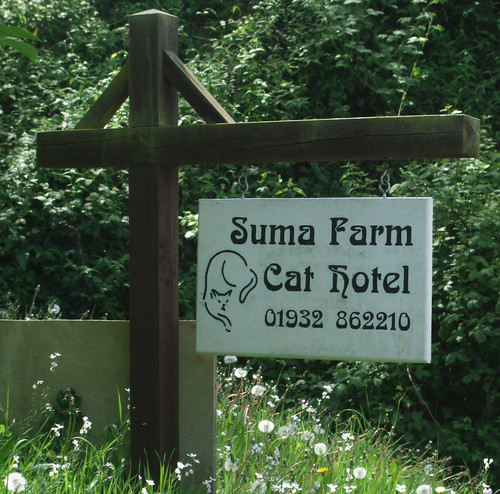
Along a lane just past the cat hotel there is a row of almshouse-type gothic cottages painted an unmissable shade of shocking pink, a refreshing contrast to the manorial stockbroker belt properties that surround it.
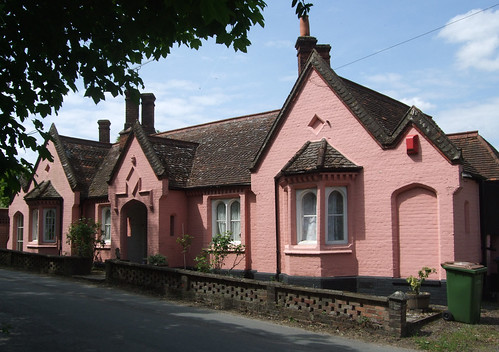
Along another broad surfaced drive, in evidence of local prosperity, a vast mansion can be seen across the fields to the right. This is Hatchford Park, an 1850s mansion on the site of an older manor house which once served as a school but is now a complex of luxury flats and houses. If it looks a bit too red and fake, that's because it's been substantially rebuilt following a disastrous fire in 2000. It also served as a Doctor Who location, appearing as a cottage hospital in Jon Pertwee's debut story, 'Spearhead from Space' (1970). Beyond the fields on the left is the site of the former Wisley Airfield, on land requisitioned by the military in 1943 on the basis that it would be returned immediately after the war. That promise was broken -- instead the airfield was used for testing purposes by Vickers until 1973 when it fell out of use, and the footpaths were only reinstated in 1985. Local campaigners have since fought off plans for executive jets, housing development and waste disposal and the land is still unused. A sign on a gatepost rather worryingly announces that the horses in the adjoining field are security tagged, and further along the drive is another luxury homes complex behind solid security gates.
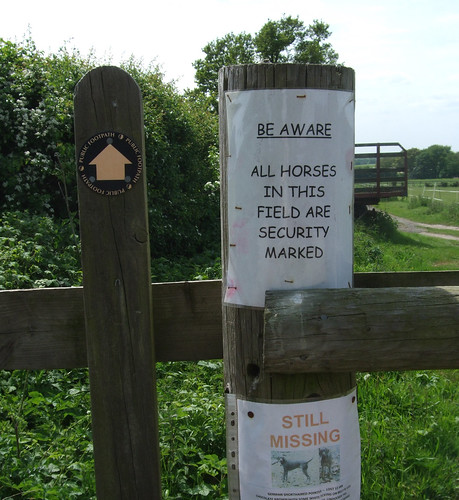
A short distance beyond, through Hatchford Wood, the surroundings change dramatically and unexpectedly from the verdant agricultural countryside so far encountered. The path climbs slightly and the woodland opens out into an extensive area of scrubby heath sloping up in front of me, with an undulating, sandy surface colonised by untidy patches of heather and tough shrubs, with older trees -- thin birch and straggly Scots Pine -- dotted among them. This is Chatley Heath, part of a 336ha chunk of heathland that also includes Ockham and Wisley Commons.
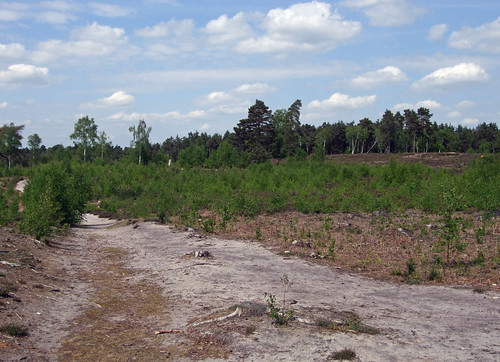
It seems a wild, random landscape but again it's the result of millennia of human management of areas with poor, sandy, acidic soil that doesn't retain sufficient nutrients for cultivation. Prehistoric farmers cleared the trees of what would have been virgin forest and sent in the cows, whose grazing of young shoots prevented the woodland reestablishing itself, leaving opportunities for a select few plant species that could adapt to these conditions, such as heather, gorse and bracken. Over time many of the heathy areas in southeast England became commons which local people had the right to use for rough grazing, but with economic change these uses ceased and many of the heaths either reverted to woods or were developed in other ways. It might not be the image that springs to mind when you think of the Surrey countryside but the county retains 13% of the UK total of lowland heath. Much of it, as here, is owned by the county council and managed by Surrey Wildlife Trust as designated nature reserves, with selective tree clearance and the restoration of grazing now helping conserve its unique character. This particular complex of heaths is a Local Nature Reserve, a Site of Special Scientific Interest and a European Special Protection Area.
I've decided to take a liberal approach to Chesterton's original route across the commons -- when his guide was published, a footbridge connection across the A3 was planned but not yet open, so rerouting to take advantage of this is justified, and I'd also like to visit a landmark which he mentions as a detour, and which has fascinated me ever since I first saw the photo of it in the 1981 guidebook. So first I head east, to Chatley Semaphore Tower. This is also, incidentally, the closest we've been for a while to the M25 -- it's only 250m or so northeast of the tower but in a deep cutting that stops its noise from being too intrusive.
Telecommunications -- the technology to send messages beyond the reach of a voice and independent of people or animals having to carry them -- didn't start with the electronic era of Morse, Edison and Bell. Among early examples like smoke and drum signals were the ancient chains of beacon hills sometimes used to warn of foreign invaders. These could send only a single bit of information but in the late 18th century the same basic principle of optical transmission, enhanced by telescopes, was combined with the system of semaphore to transmit fully alphanumeric messages. Each station on a line would have two operators, one to read the semaphore from the preceding station and one to transmit the message on to the next in the chain. The British Admiralty built several such semaphore lines, of which the last and most sophisticated was the line from London to Plymouth, operational between 1822-1847 and passing through Chatley Heath. In good weather skilled operators could transmit messages accurately along the whole line in around 15 minutes -- which in the days when you can download the whole of this over-expansive blog from the other side of the world in a fraction of a second doesn't seem much, but was massively faster than even the fastest post rider.
Chatley is the only five-storey tower of the chain still standing: in the photo in Chesterton's guide it's boarded up and looks sad and derelict, but it was splendidly restored in 1989 and has become the proud symbol of the open space, with images of an admiral in traditional headgear peering through a telescope appearing on local waymarks. Presiding over a grassy green with picnic benches, it's also a venue for events and open to the public several times a year.
From the tower I strike westwards across the heath to cross onto Ockham Common, now back in the borough of Guildford. On this fine, warm day the sandy banks with their ragged pines have an almost Mediterranean atmosphere. On the western side of the common I'm back into woods of Currie's Clump and a path that leads to the A3 Portsmouth Road footbridge, taking me across the first single digit road I've encountered since the A2 just south of Gravesend near the start of the walk, the increasing numbers a sure sign of my clockwise capital-encircling course.
The A3, as its name here suggests, is a historic surface link between London and England's principal naval port of Portsmouth and was one of the first "arterial routes" to be designated in the early 1920s. At its north end it's the single digit road that gets closest to the original focal point of the strategic road network at the Bank of England, starting at Monument station and running south across London Bridge. Like many such roads it originally ran through town centres which have since been bypassed -- one of Britain's earliest bypasses takes it around Kingston, for example -- but here, just south of its junction with the M25 at the Wisley interchange, it's still on its original alignment, although massively widened to near-motorway standards with a three-lane carriageway and hard shoulder, all under the gaze of CCTV.
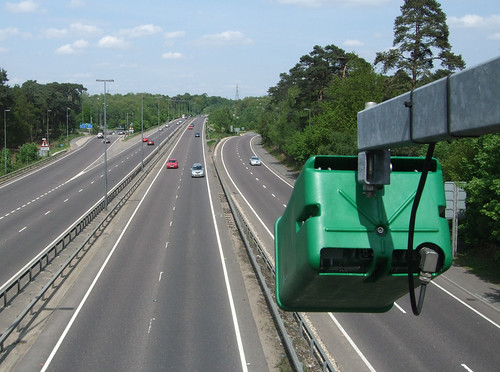
On the other side is Wisley Common, sandier and rougher-looking than Ockham Common. The route winds around Hut Hill, surmounted not by a hut but a cottage, and turns north through an area where some stocky black and white cattle are grazing to a car park on Wisley Lane, almost opposite the northern entrance of Wisley Gardens.
The Royal Horticultural Society Garden at Wisley has its nucleus in the Oakwood Experimental Garden started in 1878 by businessman and horticulturalist George Ferguson Wilson adjoining his newly purchased house, Oakwood -- the site is now the Wild Garden. The next owner, Quaker gardening enthusiast Sir Thomas Hanbury, gifted this and a wider estate of uncultivated woodland as well as the adjoining Glebe Farm to the RHS in 1903. The 24ha site is now the Society's flagship public garden and a major visitor attraction, although its use as a site for testing cultivation techniques and experimenting with new varieties and species has continued. The Countryway takes a fenced public footpath through recently installed tall kissing gates intended to keep out animals, running initially between two sections of the garden -- but if you're tempted to take a free tour through gates on each side that are sometimes left open, do take note of the notices on the fences reminding you the RHS is a charity.
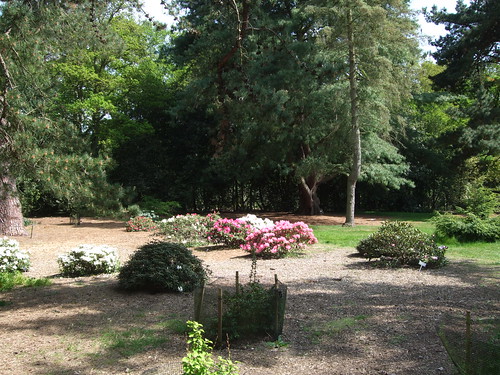
Shortly, the path runs alongside a watercourse on the right -- the river Wey. This rises as two separate branches at Blackdown and Alton in Hampshire, and joins the Thames at Weybridge, outside the London boundary. This short but attractive length of path is the first significant secton of waterside walking on our route for some time, with much more to come. Leaving the river and rounding a corner, there's a fine view to the left of Wisley's spectacular new Glasshouse, designed by Dutch architect Peter van der Toorn Vrijthoff and opened by celebrity gardener Alan Titchmarsh to mark the RHS's bicentenary in 2007.

The route then pulls away from the edge of the garden to cross more commercial-looking horticultural land with plastic cloches, emerging on a lane a short distance from Ockham Mill. This is about the closest we get to the village of Ockham, noted as the birthplace of philosopher William of Ockham (c1288-c1348), celebrated wielder of Ockham's Razor, still an essential weapon in the armoury of anyone battling silly and irrational ideas.
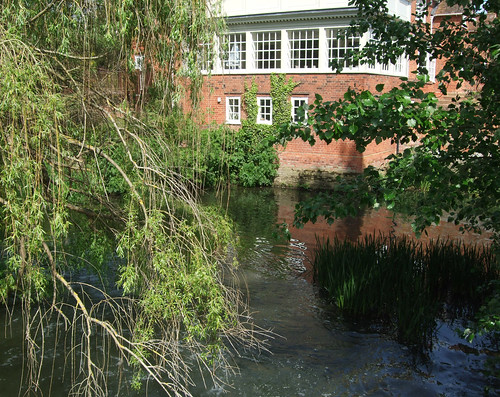
Inevitably, the mill has been converted for private housing but the mill race, fed by a stream that runs into the Wey, still churns refreshingly beneath sheltering willows. An old lane, Wharf Lane, leads me on and across the river itself on a wooden bridge, crossing the boundary into Woking District.
Update October 2018. Pigeonhouse Footbridge, the wooden bridge mentioned above, was badly damaged by floods in winter 2013-14 and had to be removed with little immediate hope of replacement given the state of council funding. A second bridge, a short distance upstream from the missing one, is the private property of Wisley Golf Club and negotiations to access it proved complicated. So for a long time a southerly dogleg diversion was in place from Mill Lane, crossing the navigation at Walsham Lock. I now understand that as of 14 August 2018 the original path is open again, with access agreed over the golf course bridge, in part necessitated by the fact that there are now access problems at Walsham Lock! So it looks like Countryway walkers can now return to almost the original route. Even so my advice is to proceed with caution and follow any signs and notices on the site carefully. Thanks to Mappiman for the news.
This canalised section of the Wey is one of Britain's earliest artificial watercourses, opening in 1653 to give various mills around Guildford access to London via the Thames and later extended to Godalming via the Godalming Navigation. Curiously, unlike many canals, it remained functional and self-supporting even in the railway era and still does, having been donated to the Trust in 1964 by its last commercial owners -- though these days the income is from licenses for the many pleasure craft that use the waterway in this particularly prosperous corner of England. Also rejoining the route here, though unsigned on the ground, is the E2 European Long Distance Path, which has taken a dogleg route along the North Downs Way to Guildford and then north along the towpath.

Joining the towpath northwards I pass the picturesque Pyrford Lock where the waterside Anchor pub beside the narrow road bridge is doing a roaring trade, the marina just beyond it crowded with narrowboats in traditional colours.
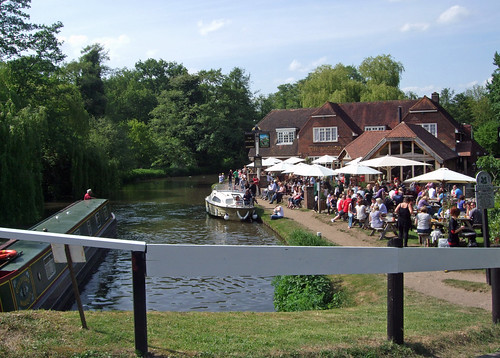
On this fine Sunday I find myself sharing the towpath not only with numerous walkers but also cyclists. Tucked away in the small print of the information board by the lock is a note that responsible cyclists are welcome so long as they give way to pedestrians -- though not everyone seems to have read this. I overhear a cyclist clearly narked that I didn't immediately leap out of his path when he rang his bell from behind on a particularly narrow stretch say to his companion, "I think these walkers are making a point because they're pissed off at us using their paths." Too right if that's the way they behave.
At the next footbridge, Dodd's Bridge, the Countryway leaves the Navigation, while the E2 continues, shall we say, doggedly on another dogleg to the Thames at Weybridge where it turns upriver towards our next encounter. My route follows Dodds Lane, a broad bridleway with a bonded gravel surface clearly installed relatively recently to satisfy the needs of cyclists and other wheeled users while providing a comfortable surface underfoot and not intruding too much on the rural character as tarmac can sometimes do. I can only approve. The path winds alongside hedgerows and across a meadow to reach houses on the edge of West Byfleet.
West Byfleet was originally simply the west end of the ancient Parish of Byfleet, a settlement on the west bank of the river Wey dating back to Neolithic times -- the name simply means "by the river". The estate has an association with the Duchy of Cornwall -- one of the manor's better-known occupants was Edward the "Black Prince" (1330-76), the first Duke of Cornwall and later Prince of Wales. Byfleet village, now on the other side of the M25, has a heritage centre in the library which tells the story, opened by no less a distinguised personage than Sir Cliff Richard.
Today this whole area is part of a more-or-less continuous strip of urban sprawl from southwest London through Weybridge to Woking, in the middle of which, like the copper core in a ribbon of cable, is the railway. The London and South Western Railway opened between Nine Elms station at Vauxhall, another area with historic links to Cornwall and the Black Prince that we'll visit on a later walk, and Woking Heath in 1838 as the first stage of a line to Southampton, at a stroke turning a quiet area of Surrey heathland into a potential commuter belt for London workers. The railway ran some distance north of Byfleet village and West Byfleet -- originally Woodham and Byfleet -- became the first station in the parish when it opened in 1887 on what was then common land but was soon under development. From 1852 it was also used by less lively passengers -- the trains of the Necropolis Railway ran through here from their own special terminal at Waterloo to the massive cemetery at Brookwood on the edge of Woking -- a last resting place near the extreme tip of an arm of the capital's sprawl.
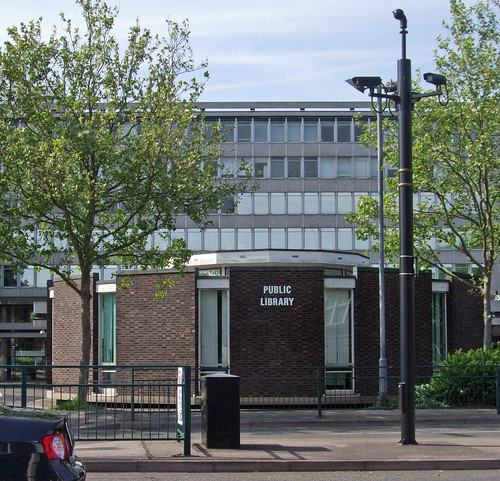
Some of the big houses I pass along Pyrford Road are Victorian or Edwardian but the centre of the village is pure early 197os -- a concrete block shopping centre and library which local councillors calling for its redevelopment recently described as "like East Berlin". Brutal and decaying it may be, but personally I hope at least some examples of this building style are preserved and they don't all fall to current postmodernist fads. Rather than the prescribed route along Station Approach I keep straight ahead on a parallel course for a while, along the walkway past shops, then down onto Station Approach to reach the rather unwelcoming sight of the station wall.

A final feature of interest is the brightly coloured murals by local schoolchildren in the station subway, while the station itself turns out to be a functional modern building looking out onto a pleasant but underexploited green. The trains today are operated by South West Trains out of Waterloo, the changing National Rail franchises on the radial routes from London another sign of our slow but sure progress.
View a map http://maps.google.co.uk/maps/ms?ie=UTF8&hl=en&oe=UTF8&msa=0&msid=117966169375523396049.00046414d40d8252e7b70&num=200&start=73&z=11
Route description pdf
More information
- Surrey County Council http://www.surrey.gov.uk/
- Surrey Countryside http://www.surreycc.gov.uk/countryside
- Surrey Interactive Maps http://surreymaps.surreycc.gov.uk/
- Surrey Walking (John Harris) http://www.walkinginsurrey.co.uk/
- Visit Surrey http://www.visitsurrey.com/
- Exploring Surrey's Past http://www.exploringsurreyspast.org.uk/
- Guildford Borough Council http://www.guildford.gov.uk/
- Guildford Parks and Countryside http://www.guildford.gov.uk/GuildfordWeb/Leisure/ParksCountryside/
- Guildford Tourism http://www.visitguildford.com/
- East Horsley (Wikipedia) http://en.wikipedia.org/wiki/East_Horsley
- New Guildford Line (Wikipedia) http://en.wikipedia.org/wiki/New_Guildford_Line
- Horsley Countryside Preservation Society http://surreycommunity.info/hcps/
- Horsley Jubilee Trail -- leaflet from Surrey Hills AONB or see
http://www.geograph.org.uk/article/Horsley-Jubilee-Trail - Surrey Wildlife Trust http://www.surreywildlifetrust.co.uk/
- Our Places - Surrey Wildlife Trust (The Forest, Wisley & Ockham Commons, Chatley Heath) http://www.surreywildlifetrust.co.uk/Default.asp?EntityID={E6649CB3-2A6E-428D-BCE1-2D309F16379B}
- Elmbridge Borough Council http://www.elmbridge.gov.uk/
- Elmbridge: Getting active outdoors http://www.elmbridge.gov.uk/leisure/outdoors.htm
- Visiting Elmbridge http://www.elmbridge.gov.uk/Tourism/
- Basics of footpath law (Ramblers) http://www.ramblers.org.uk/info/britain/footpathlaw/
- Wisley Airfield (unofficial site) http://www.wisleyairfield.co.uk/
- Ockham Parish Council http://www.surreycommunity.info/ockhamparishcouncil/
- Semaphore line (Wikipedia) http://en.wikipedia.org/wiki/Optical_telegraph
- A3 (Wikipedia) http://en.wikipedia.org/wiki/A3_road_(England)
- RHS Gardens: Wisley http://www.rhs.org.uk/whatson/gardens/wisley/index.asp
- European Ramblers Association http://www.era-ewv-ferp.org/
- E2 (Ramblers) http://www.ramblers.org.uk/info/paths/name/e/e2.htm
- National Trust http://www.nationaltrust.org.uk/
- River Wey and Godalming Navigations (National Trust) http://www.nationaltrust.org.uk/main/w-riverwey_godalmingnavigations_dapdunewharf
- Woking Borough Council http://www.woking.gov.uk/
- Woking Green Spaces http://www.woking.gov.uk/leisure/greenspaces
- Visiting Woking http://www.woking.gov.uk/woking/visit/
- West Byfleet (Woking council) http://www.woking.gov.uk/council/planning/localplan/westbyfleet
- Byfleet Heritage Society http://www.geocities.com/byfleetuk/
- West Byfleet station (Wikipedia) http://en.wikipedia.org/wiki/West_Byfleet_railway_station
- South Western Main Line (Wikipedia)
http://en.wikipedia.org/wiki/South_Western_Main_Line




8 comments:
[Comment deleted and rewritten because I spotted a couple of typos in the first version and cannot see a way to edit it after posting here]
I reached this section of the London Countryway today and can confirm that the bridge over the Wey no longer exists. There is a sign just north of Ockham Mill, and another at where the path meets the Wey Navigation, reading Pigeon House Footbridge closed ahead see notices for alternative route. Apologies for the inconvenience. Please do not trespass on Wisley Golf Club property. 03456 009 009. Surrey County Council.
The alternative route suggested is longer than necessary, apparently because it uses only numbered footpaths, so that from Ockham Mill it goes via Ripley Green, Fox Way, Pyrford Place, Pyrford Green and Manor Farm. I found it perfectly easy to start off south along the footpath from Mill Lane, just before the mill, then cut across a patch of rough grass on a foopath which is marked on the OS map, though not as a right of way, to go directly to the south-east end of Fox Way. Following the towpath then makes it unnecessary to visit the Pyrfords.
There is another sad notice from the County Council's Countryside Access Team, explaining that replacing the bridge would cost £300,000 to £400,000, and that they can't afford that. I don't know the background to the story, but it seems regrettable that the golf club seem to have refused permission for walkers to use their splendid large footbridge which spans the Wey only a few yards north of the missing one. Diverting the footpath to allow that would involve only a mimimal encroachment on the private golf course. Even if the Council were to pay the club to create a permissive path, and indemnify them against liability to the public, it would surely cost less than an unnecessary new bridge.
Thanks for this, Leonard. I'm planning to have a look down there at some stage but haven't had a chance yet. Will also see if I can find out anymore about if the problem is likely to be solved.
London City of Science left the following comment on the main London Countryway index page, copied here as it may be useful to those walking the section:
Beautiful day to enjoy the varied walk from Horsley to West Byfleet. Before leaving I printed out the pdf file from: https://goo.gl/xa1s73. Forewarned (thank you) it was easy to go straight across Mill Lane from the footpath from Wisley to pick up Bridleway 33 (see pdf download). Care is needed to fork right off the bridleway onto the footpath 531 after the second footbridge. Coming out of the woodland it is possible to cut across to the northern end of Ripley Green (see dotted path on map) to pick up footpath 34 which leads easily to the lock on the navigation. Walsham lock is the last turf sided lock and so worth a visit. This is an attractive diversion/extension to the Countryway and the extra walking along the towpath was very pleasant on a sunny afternoon.
Now see the latest good news about the bridge situation on this blog:
https://mappiman.blogspot.com/2018/09/220918-london-countryway-stage-8.html
Thanks LCS. I've already incorporated Mappiman's report into the blog text and the route description. It's very good news.
There is a new problem with a bridge on this leg of the walk. Not at the golf club, but with the footbridge over the A3 between Ockham Common and Wisley Common. There are major roadworks at the A3/M25 junction, and the footpath and footbridge used by the Countryway to cross the A3 are closed until the end of 2025, with, according to notices at the site, no alternative route provided.
But there is an alternative. Just under a mile south-west along the A3, a new road bridge has been built which provides much better road access to the RHS Gardens at Wisley. This bridge has a really wide pavement, so it's possible to use as a pedestrian.
To get there, starting at the car park for Ockham Common on Old Lane, I first walked along Old Lane, away from the A3, and then turned right onto Elm Lane. There are probably footpaths through the adjacent woodland if you prefer, but I didn't investigate this.
At the end of Elm Lane, there is a massive barrier in the road with "road closed" signs. But on closer inspection, a narrow gap has been left allowing pedestrians to pass. As soon as you're through this barrier, a pedestrian diversion route is clearly marked out with temporary signs and fencing, although it's not obvious where it's taking you to!
Fortunately it brings you straight out onto the new access road to Wisley Gardens. When you reach this road, stop following the diversion signs (which point you left along the road) and instead turn right, towards the bridge.
Immediately after the crossing the bridge, there is a turning to the right that lets you access Wisley Common so you can head back to the other side of the closed footbridge if you want to. Or if you're not bothered about walking every last inch of the original Countryway route, you can skip Wisley Common by just following the road towards Wisley village (which doesn't have a pavement any more, but you can use the RHS car park instead of the road if you prefer). This lets you rejoin the Countryway at the northern end of Wisley Gardens.
I’m currently walking the London Countryway (LCW) for the second time, this time anti-clockwise, and yesterday (Mon 11 Aug) did the West Byfleet to Horsley section. This is to endorse Jon’s comment, above, re crossing A/M3, and also to say that the rest of this LCW section is ok/as the Description (including golf-course bridge, which is open/accessible).
To reiterate briefly: if walking the route anti-clockwise, when you exit the path round edge of Wisley Gardens onto Wisley Lane, instead of crossing Lane onto Wisley Common, turn R and walk up Lane half a mile until it crosses M3 on new road bridge. (The Wisley Common alternative is pretty much impassable now because of all the works). Immediately on far side of bridge drop down to L onto the original Elm Lane, now a site-access road but accessible. Follow Elm Lane ahead then to L, after which reverse Jon’s directions above to get to cafe/car park. From here you can access existing LCW route up onto Okham Common and beyond.
Post a Comment